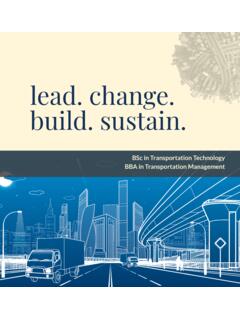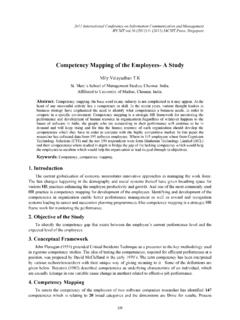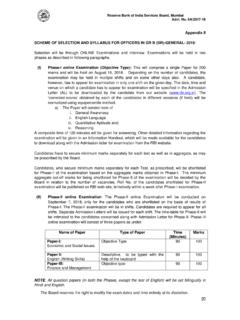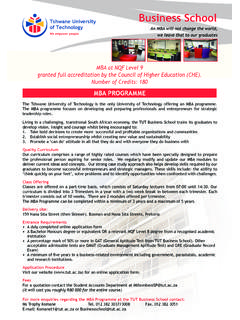Transcription of SYLLABUS - STATE LEVEL ELIGIBLITY TEST …
1 (2) SYLLABUS /CommerceSyllabus/ commerce (1) SYLLABUSCOMMERCENote :There are Three Papers for each of the subjects. Paper-I onTeaching and Research aptitude , Paper -II and Paper-IIIbased on the SYLLABUS of concerned subjects. Details arefurnished below :PAPER -ISubject : General Paper on Teaching & Research AptitudeThe test is intended to assess the teaching/research aptitude ofthe candidate. They are supposed to possess and exhibit cognitiveabilities like comprehension, analysis, evaluation, understandingthe structure of arguments, evaluating and distinguishingdeductive and inductive reasoning, weighing the evidence withspecial reference to analogical arguments and inductivegeneralization, evaluating, classification and definition, avoidinglogical inconsistency arising out of failure to see logical relevancedue to ambiguity and vagueness in language.
2 The candidates arealso supposed to have a general acquaintance with the nature ofa concept, meaning and criteria of truth, and the source will be 60 questions, out of which the candidates canattempt any 50. In the event of the candidate attempting morethan 50 questions, the first 50 questions attempted by thecandidate will only be Test will be conducted in objective mode fromSET 2012 onwards. The Test will consist of three papers. Allthe three papers will consists of only objective type questionsand will be held on the day of Test in two separate sessions asunder :Session PaperNumber ofMarksDurationQuestionsFirstI60 out of which50%2=1001 Hours50 questions are to be attemptedFirstII50 questions all50%2=1001 Hoursofwhich arecompulsorySecondIII75 questions all75%2=1502 Hoursof which candidates are required to obtain minimummarks separately in Paper-II and Paper -III as given belowMinimum marks (%) to be obtainedCategoryPaper-IPaper-IIPaper-III G eneral40 (40%)40 (40%)75 (50%)OBC35 (35%)35 (35%) (45%) roundedoff to 68PH/VH/35 (35%)35 (35%)60 (40%)
3 SC/STOnly such candidates who obtain the minimumrequired marks in each Paper, separately, as mentioned above,will be considered for final preparation of , the final qualifying criteria for eligibil-ity for Lectureship shall be decided by Steering Committeebefore declaring of SYLLABUS of Paper-I, Paper-II and Paper-III willremain the same.(4) SYLLABUS /CommerceSyllabus/Commer ce(3)COMMERCEPAPER - II & PAPER -III (A)(Core Group)Unit - I : Business EnvironmentMeaning and Elements of Business EnvironmentEconomic environment, Economic Policies,Economic Planning,Legal environment of Business in policy, Consumer protection,Environment Environment : Liberalization, Priyatisationand globalisation.
4 Second generation reforms,Industrial policy and implementation. Industrialgrowth and structural - II : Financial & Management AccountingBasic Accounting concepts, Capital and Revenue,Financial statementsPartnership Accounts : Admission, Retirement,Death, Dissolution and Cash DistributionAdvanced Company Accounts : Issue, forfeiture,Purchase of Business Liquidation, Valuation ofshares, Amalgamation, Absorption Reconstruction,Holding Company AccountsCost and Management Accounting : Ratio Analysis,Funds Analysis, Cash Flow Analysis, Marginalcosting and Break-even analysis, Standard costingBudgetary control, Costing for decision-makingResponsibility accountingUnit - III.
5 Business EconomicsNature and uses of Business Economics, Conceptof Profit and Wealth maximization. DemandAnalysis and Eleasticity of Demand, Curve Analysis and Indifference of Returns and Lawof variable proportion Cost, Revenue,Price determination in different market situation :Perfect competition, Monopolistic competition,Monopoly, Price discrimination and Oligopoly,Pricing StrategiesUnit - IV : Business Statistics & Data ProcessingData types, Data collection and analysis, sampling,need, errors and methods of sampling, Normaldistribution, Hypothesis testing, Analysis andInterpretation of DataCorrelation and Regression, small sample tests -t-test, F-test and chi-square testData processing - Elements.
6 Data entry, Dataprocessing and Computer applicationsComputer Application to Functional Areas-Accounting, Inventory control, MarketingUnit - V : Business ManagementPrinciples of ManagementPlanning - Objectives, Strategies, Planning Process,Decision-makingOrganising, Organisational structure, Formal andinformal organisations, Organisational cultureStaffingLeading : Motivation, Leadership, Committees,Communication ControllingCorporate Governance and Business Ethics(6) SYLLABUS /CommerceSyllabus/Comme rce(5)Unit - X : International BusinessTheoretical foundations of international business,Balance of payments International liquidity,International Economic Institutions - IMF, WorldBank, IFC, IDA, ADBW orld Trade Organisation-its functions and policiesStructure of India s foreign trade : Composition Bank EXIM Policy of India, Regulation andPromotion of Foreign TradePAPER -III (B)(Elective/Optional)Elective-I.
7 Accounting and FinanceAccounting standards in India, InflationAccounting, Human Resource Accounting,Responsibility Accounting, Social AccountingMoney and Capital market, Working of stockexchanges in India,NSE, OTCEI, NASDAQ, Derivative and OptionsRegulatory Authorities : SEBI, Rating Agencies;New Instruments : GDRs ADRsVenture Capital Fund. Mergers and Acquisitions,Mutual Funds, Lease Financing, Factoring,Measurement of risk and returns securities andportfoliosComputer Application in Accounting and FinanceElective-II : MarketingMarketing Tasks, Concepts and Tools, MarketingEnvironmentConsumer Behaviour and Market SegmentationProduct decisionsPricing decisionsDistribution decisionsPromotion decisionsUnit - VI.
8 Marketing ManagementThe evolution of marketing, Concepts, Concept ofmarketing, Marketing mix, Marketing environmentElements of consumer behaviour, MarketsegmentationProduct decisionsPricing decisionsDistribution decisionsPromotion decisionsMarketing planning, Organising and ControlUnit - VII : Financial ManagementCapital Structure, Financial and Operating leverageCost of capital, Capital budgetingWorking capital managementDividend PolicyUnit - VIII : Human Resources ManagementConcepts, Role and Functions of Human Resourcemanagement, Human Resource Planning,Recruitment and SelectionTraining and Development, Succession PlanningCompensation : Wage and Salary Administration,Incentive and Fringe and ProductivityPerformance AppraisalIndustrial Relations in India, Health, Safety, Welfareand Social security, Workers Participation - IX.
9 Banking and Financial InstitutionImportance of Banking to Business, Types of Banksand Their Functions, Reserve Bank of India,NABARD and Rural Banking,Banking Sector Reforms in India, NPA, Capitaladequacy norms E-bankingDevelopment Banking : IDBI, IFCI, SFCs, UTI,SIDBI(8) SYLLABUS /CommerceSyllabus/Co mmerce(7)Elective-V : Income tax Law and Tax PlanningBasic Concepts, Residential status and taxincidence exempted income, computation oftaxable income under various headsComputation of taxable income of individuals andfirmsDeduction of tax, filing of returns, different typesof assessment; Defaults and penaltiesTax planning : Concept, significance and problemsof tax planning.
10 Tax evasion and tax avoidance,methods of tax planningTax considerations in specific business decisions,viz., make or buy; own or lease, retain or replace;export or domestic sales; shut-down or closure;expand or contract; invest or disinvestComputer Application in Income tax and Taxplanning_____Marketing ResearchsOn-line MarketingDirect Marketing; Social, ethical and legal aspectsof marketing in IndiaElective-III : Human Resource ManagementConcept : Role and Function of Human ResourceManagerHuman Resource Planning, Job analysis, Jobdescription and specifications, Use of Job analysisinformation, Recruitment and SelectionTraining and Development, Succession PlanningCompensation : Wage and Salary administration,Incentives and Fringe benefits, Morale andProductivityAppraisal of PerformanceIndustrial Relations in India, Health, Safety,Welfare and Social Security, Workers participationin ManagementElective-IV.





